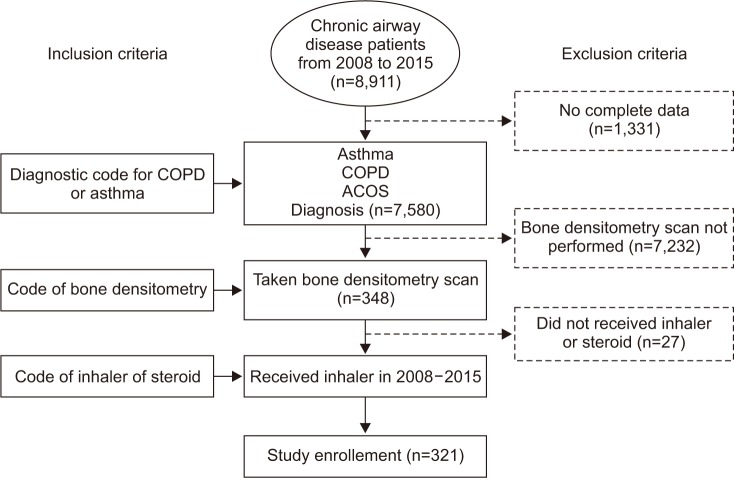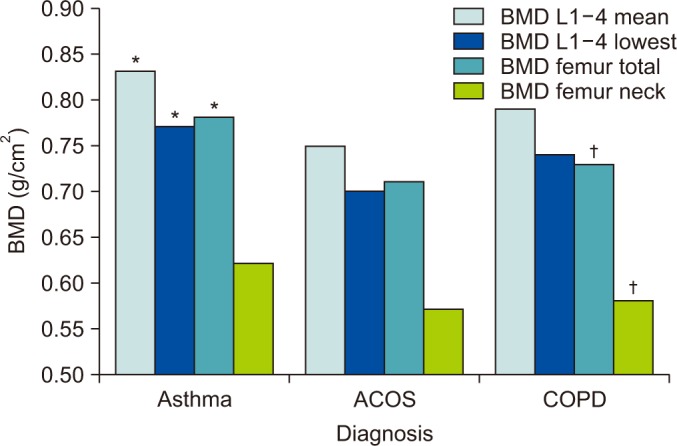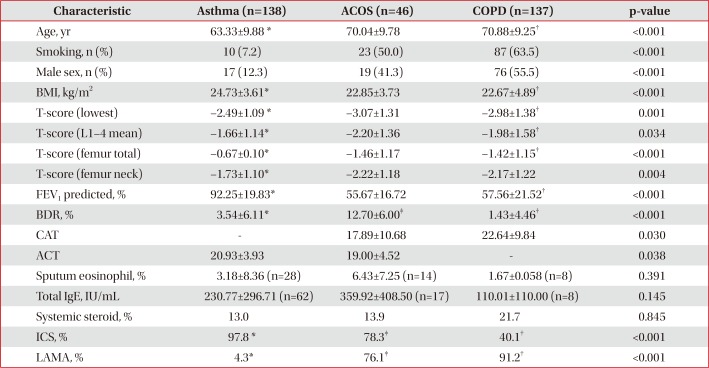1. Biskobing DM. COPD and osteoporosis. Chest. 2002; 121:609–620. PMID:
11834678.

2. Weldon D. The effects of corticosteroids on bone growth and bone density. Ann Allergy Asthma Immunol. 2009; 103:3–11. PMID:
19663120.

3. Chee C, Sellahewa L, Pappachan JM. Inhaled corticosteroids and bone health. Open Respir Med J. 2014; 8:85–92. PMID:
25674178.

4. Kelly HW, Nelson HS. Potential adverse effects of the inhaled corticosteroids. J Allergy Clin Immunol. 2003; 112:469–478. PMID:
13679801.

5. Jorres RA, Welte T, Bals R, Koch A, Schnoor M, Vogelmeier C. Systemic manifestations and comorbidities in patients with chronic obstructive pulmonary disease (COPD) and their effect on clinical state and course of the disease: an overview of the cohort study COSYCONET. Dtsch Med Wochenschr. 2010; 135:446–449. PMID:
20198540.
6. Omoigui S. The Interleukin-6 inflammation pathway from cholesterol to aging: role of statins, bisphosphonates and plant polyphenols in aging and age-related diseases. Immun Ageing. 2007; 4:1. PMID:
17374166.

7. Katsura H, Kida K. A comparison of bone mineral density in elderly female patients with COPD and bronchial asthma. Chest. 2002; 122:1949–1955. PMID:
12475832.

8. Menezes AM, Montes de Oca M, Perez-Padilla R, Nadeau G, Wehrmeister FC, Lopez-Varela MV, et al. Increased risk of exacerbation and hospitalization in subjects with an overlap phenotype: COPD-asthma. Chest. 2014; 145:297–304. PMID:
24114498.
9. Hardin M, Silverman EK, Barr RG, Hansel NN, Schroeder JD, Make BJ, et al. The clinical features of the overlap between COPD and asthma. Respir Res. 2011; 12:127. PMID:
21951550.

10. de Marco R, Pesce G, Marcon A, Accordini S, Antonicelli L, Bugiani M, et al. The coexistence of asthma and chronic obstructive pulmonary disease (COPD): prevalence and risk factors in young, middle-aged and elderly people from the general population. PLoS One. 2013; 8:e62985. PMID:
23675448.

11. Soler-Cataluna JJ, Cosio B, Izquierdo JL, Lopez-Campos JL, Marin JM, Aguero R, et al. Consensus document on the overlap phenotype COPD-asthma in COPD. Arch Bronconeumol. 2012; 48:331–337. PMID:
22341911.
12. Iwamoto H, Gao J, Koskela J, Kinnula V, Kobayashi H, Laitinen T, et al. Differences in plasma and sputum biomarkers between COPD and COPD-asthma overlap. Eur Respir J. 2014; 43:421–429. PMID:
23794464.

13. Fu JJ, McDonald VM, Gibson PG, Simpson JL. Systemic inflammation in older adults with asthma-COPD overlap syndrome. Allergy Asthma Immunol Res. 2014; 6:316–324. PMID:
24991455.

14. Lim WH, Wong G, Lim EM, Byrnes E, Zhu K, Devine A, et al. Circulating lipocalin 2 levels predict fracture-related hospitalizations in elderly women: a prospective cohort study. J Bone Miner Res. 2015; 30:2078–2085. PMID:
25939604.

15. Dontas IA, Yiannakopoulos CK. Risk factors and prevention of osteoporosis-related fractures. J Musculoskelet Neuronal Interact. 2007; 7:268–272. PMID:
17947811.
16. Tucker KL. Osteoporosis prevention and nutrition. Curr Osteoporos Rep. 2009; 7:111–117. PMID:
19968914.

17. van Boven JF, Roman-Rodriguez M, Palmer JF, Toledo-Pons N, Cosio BG, Soriano JB. Comorbidome, pattern, and impact of asthma-COPD overlap syndrome in real life. Chest. 2016; 149:1011–1020. PMID:
26836892.

18. Ferguson GT, Calverley PM, Anderson JA, Jenkins CR, Jones PW, Willits LR, et al. Prevalence and progression of osteoporosis in patients with COPD: results from the TOwards a Revolution in COPD Health study. Chest. 2009; 136:1456–1465. PMID:
19581353.
19. Mineo TC, Ambrogi V, Mineo D, Fabbri A, Fabbrini E, Massoud R. Bone mineral density improvement after lung volume reduction surgery for severe emphysema. Chest. 2005; 127:1960–1966. PMID:
15947308.

20. Bobolea I, de Llano LA. Asthma-COPD overlap syndrome (ACOS): current understanding and future perspectives, asthma-from childhood asthma to ACOS phenotypes. Dublin: InTech;2016.
21. Liu WT, Kuo HP, Liao TH, Chiang LL, Chen LF, Hsu MF, et al. Low bone mineral density in COPD patients with osteoporosis is related to low daily physical activity and high COPD assessment test scores. Int J Chron Obstruct Pulmon Dis. 2015; 10:1737–1744. PMID:
26366066.
22. Jones PW, Tabberer M, Chen WH. Creating scenarios of the impact of COPD and their relationship to COPD Assessment Test (CAT) scores. BMC Pulm Med. 2011; 11:42. PMID:
21835018.

23. Graat-Verboom L, Wouters EF, Smeenk FW, van den Borne BE, Lunde R, Spruit MA. Current status of research on osteoporosis in COPD: a systematic review. Eur Respir J. 2009; 34:209–218. PMID:
19567604.

24. Graat-Verboom L, Spruit MA, van den Borne BE, Smeenk FW, Martens EJ, Lunde R, et al. Correlates of osteoporosis in chronic obstructive pulmonary disease: an underestimated systemic component. Respir Med. 2009; 103:1143–1151. PMID:
19304474.

25. Jorgensen NR, Schwarz P, Holme I, Henriksen BM, Petersen LJ, Backer V. The prevalence of osteoporosis in patients with chronic obstructive pulmonary disease: a cross sectional study. Respir Med. 2007; 101:177–185. PMID:
16677808.
26. Hattiholi J, Gaude GS. Prevalence and correlates of osteoporosis in chronic obstructive pulmonary disease patients in India. Lung India. 2014; 31:221–227. PMID:
25125807.

27. Bhattacharyya P, Paul R, Ghosh M, Dey R, Dey R, Barooah N, et al. Prevalence of osteoporosis and osteopenia in advanced chronic obstructive pulmonary disease patients. Lung India. 2011; 28:184–186. PMID:
21886952.

28. Raghavan N, Lam YM, Webb KA, Guenette JA, Amornputtisathaporn N, Raghavan R, et al. Components of the COPD Assessment Test (CAT) associated with a diagnosis of COPD in a random population sample. COPD. 2012; 9:175–183. PMID:
22409441.

29. Silva Junior JL, Conde MB, de Sousa Correa K, da Silva C, da Silva Prestes L, Rabahi MF. COPD Assessment Test (CAT) score as a predictor of major depression among subjects with chronic obstructive pulmonary disease and mild hypoxemia: a case-control study. BMC Pulm Med. 2014; 14:186. PMID:
25430559.

30. Hilmarsen CW, Wilke S, Engan H, Spruit MA, Rodenburg J, Janssen DJ, et al. Impact of symptoms of anxiety and depression on COPD Assessment Test scores. Eur Respir J. 2014; 43:898–900. PMID:
24114965.

31. Maurer J, Rebbapragada V, Borson S, Goldstein R, Kunik ME, Yohannes AM, et al. Anxiety and depression in COPD: current understanding, unanswered questions, and research needs. Chest. 2008; 134(4 Suppl):43S–56S.








 PDF
PDF ePub
ePub Citation
Citation Print
Print


 XML Download
XML Download